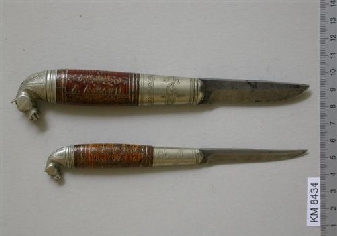 A Kauhava puukko knife made in 1892 by Juho Kustaa Lammi. Housed at the National Museum of Finland. A Brief Look At PuukkosIntroductionThe Finnish puukko or sheath-knife is an all-purpose tool and a symbol of Finnish heritage, but it’s also a dangerous weapon. According to the National Board of Antiquities, as of 2007, puukkos were used to commit 1/3 of all murders in Finland. In addition, they were the weapon used in ¾ of all attempted homicides. In Finland, it’s not legal to possess a puukko in a public place. AppearancePuukkos are short knives with a handle around 4 inches in length and a single blade that’s even shorter. Traditionally, puukkos have birch handles, or handles made from other types of wood, and the word “puukko” originally meant a “knife with a wooden handle”. Other materials tradionally used include elk horn or bone, although modern knives are often made with plastic handles. HistoryPuukkos dating back to medieval times have been found in archeological excavations of towns and castles. Local puukko making traditions began evolving during the 18th and 19th centuries. In the early 1800’s, Fiskars ironworks began manufacturing puukko knives about 62 miles west of Helsinki. By the middle of the 18th century, southern Ostrobothnia became a major knife manufacturing center. In 2007, there were 5 puukko factories and around 40 small scale puukko-makers in Finland. UsesPuukkos make good wood-carving tools and are used to make wooden spoons, containers, birch-bark objects and other items. Fishermen, soldiers and hunters all carry them. In addition, they’ve been used as cutlery and to prepare food. Puukkos are worn as part of the national costume and are seen as both a practical object and an object of art. Knife FightersThe Southern Ostrobothnian region of Finland is famous for its puukkojunkkari, or knife-fighters who were active in that region between the 1820’s and 1880’s. Knife-fighters caused trouble at weddings and funerals and had a reputation for stealing and chasing after women. Famous knife-fighters like Antti Isotalo and Antti Rannanjärvi were immortalized in popular songs. Although many knife-fighters were little more than criminals and thugs, they were often admired and respected for standing up to authority. References
|